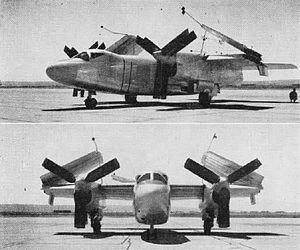Top speed 726 km/h Wingspan 22 m | Range 3,508 km Length 21 m First flight January 4, 1952 | |
 | ||
The North American Aviation XA2J "Super Savage" was a prototype carrier-based attack aircraft built in the early 1950s. It was developed by North American Aviation (NAA) from the smaller AJ Savage.
Contents
Design and development
The XA2J was intended to be a turboprop-powered derivative of the AJ Savage, with the design as initially proposed in December 1947 a simple modification of the Savage, with extensive use of components of the earlier aircraft. The design gradually evolved, however, to improve performance and increase compatibility with operations from aircraft carriers, as it was recognized that the AJ Savage was deficient in performance and was a less-than-satisfactory carrier plane.
The A2J was essentially an enlarged AJ Savage with the two reciprocating engines replaced with two Allison T40 turboprop engines and removal of the tail-mounted turbojet. Like the AJ, it was a high-winged monoplane with unswept wings. The wings were fitted with leading edge slats and large trailing edge flaps, and folded outside of the engine nacelles to ease storage aboard ship. It had a crew of three: pilot, co-pilot/bombardier and gunner who sat in a pressurised cabin in the nose of the aircraft. Up to 10,500 lb (4,800 kg) of bombs could be carried in a large enclosed bomb-bay in the center fuselage, while the planned defensive armament was a remotely controlled tail turret with two 20 mm cannon.
Construction of two prototypes started 1 October 1948, but due to delays developing the engines, the first flight was not until 4 January 1952. The competing Douglas XA3D, the prototypes of which were ordered the year after construction had begun on the XA2J prototypes, first flew in October 1952. The A3D had far superior performance, which doomed the XA2J.
The root cause for the failure of the XA2J was the protracted development and poor reliability of the Allison T40 engines. The T40 engine was an ambitious engine design with two T38 turboprop engines driving two large contra-rotating propellers through a combining gearbox. Both the engines and the gearbox proved to be unreliable. The T40 engine was also used in the developmental Douglas A2D Skyshark, and the Republic XF-84H Thunderscreech. After a number of engine-related mishaps, the XA2J project was abandoned and the second prototype was never flown.
Operators
Specifications (XA2J-1)
General characteristics
Performance
Armament
